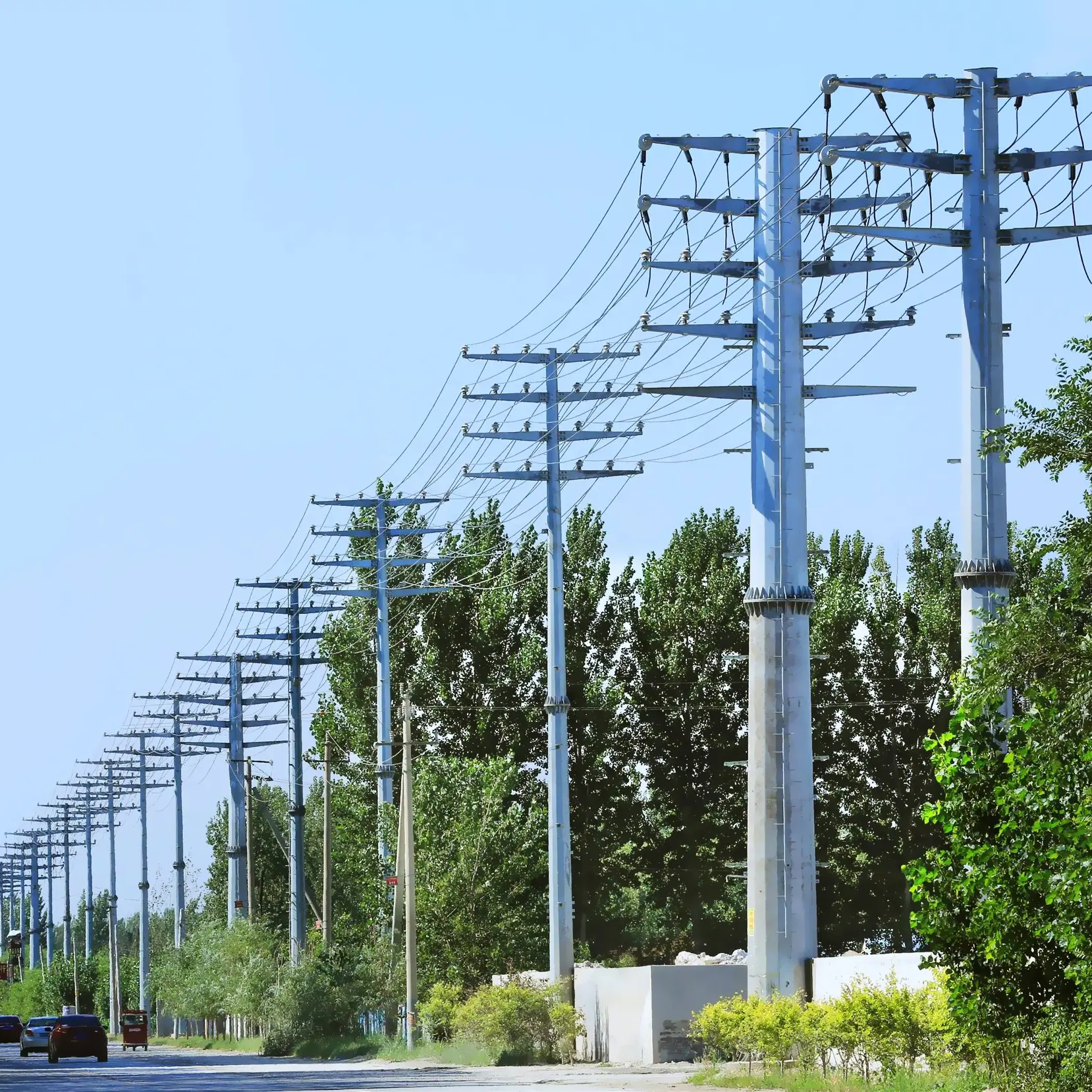สุดยอดวิศวกรรม: รากฐานของโครงสร้างพื้นฐานด้านไฟฟ้า
เสาส่งไฟฟ้า ยืนตัวอยู่อย่างเงียบงันทั่วทุกมุมโลก ทำหน้าที่เป็นแกนหลักของระบบกริดไฟฟ้าของเรา โครงสร้างขนาดใหญ่เหล่านี้ ซึ่งจำเป็นต่อการส่งไฟฟ้าข้ามระยะทางไกล เป็นตัวแทนของความสำเร็จอันน่าทึ่งในด้านวิศวกรรมและการออกแบบโครงสร้าง ความสามารถในการต้านทานสภาพแวดล้อมที่หลากหลาย ขณะยังคงจ่ายไฟฟ้าให้กับผู้คนหลายล้านคนอย่างต่อเนื่อง ขึ้นอยู่กับเทคนิคการก่อสร้างขั้นสูงและมาตรฐานความปลอดภัยที่เข้มงวด
หอคอยส่งไฟฟ้าสมัยใหม่สะท้อนการพัฒนาทางวิศวกรรมหลายทศวรรษ โดยผสานวิทยาศาสตร์วัสดุขั้นสูงเข้ากับการคำนวณโครงสร้างอย่างแม่นยำ ทุกองค์ประกอบ ตั้งแต่ความลึกของฐานรากไปจนถึงการเลือกเกรดเหล็ก มีบทบาทสำคัญในการทำให้มั่นใจว่าโครงสร้างเหล่านี้จะสามารถใช้งานได้อย่างต่อเนื่องยาวนานหลายชั่วอายุคน การทำความเข้าใจวิธีการก่อสร้างโครงสร้างอันยิ่งใหญ่เหล่านี้ ช่วยเปิดเผยความสมดุลที่ซับซ้อนระหว่างความทนทาน ความปลอดภัย และประสิทธิภาพในโครงสร้างพื้นฐานการส่งพลังงานไฟฟ้า
ระบบฐานรากและการเตรียมพื้นดิน
เทคโนโลยีฐานรากลึก
ความมั่นคงของหอคอยส่งไฟฟ้าเริ่มต้นจากใต้ดิน โดยระบบฐานรากเฉพาะทางทำหน้าที่ยึดโครงสร้างขนาดใหญ่มหึมาเหล่านี้ วิศวกรจะทำการวิเคราะห์ดินอย่างละเอียดเพื่อกำหนดประเภทฐานรากที่เหมาะสมที่สุด ไม่ว่าจะเป็นฐานรากเสาเข็มลึกสำหรับดินนิ่ม หรือฐานรากแผ่สำหรับพื้นที่ที่มีหินแข็ง ความลึกของฐานรากโดยทั่วไปจะอยู่ที่ระดับ 15 ถึง 30 ฟุตใต้ระดับพื้นดิน ขึ้นอยู่กับสภาพดินและความสูงของหอคอย
การออกแบบฐานรากที่ทันสมัยใช้คอนกรีตเสริมเหล็กพร้อมการจัดวางเหล็กอย่างแม่นยำเพื่อกระจายแรงได้อย่างมีประสิทธิภาพ การจำลองด้วยคอมพิวเตอร์ขั้นสูงช่วยให้วิศวกรคำนวณรายละเอียดเฉพาะสำหรับแต่ละตำแหน่งได้อย่างถูกต้อง เพื่อให้มั่นใจว่าฐานรากสามารถรองรับทั้งแรงในแนวตั้งและแรงด้านข้างจากลมและการสะสมของน้ำแข็ง
การประเมินพื้นที่และการเตรียมงาน
ก่อนเริ่มการก่อสร้าง จะมีการสำรวจทางธรณีวิทยาอย่างครอบคลุมเพื่อทำแผนที่ลักษณะใต้ดินและองค์ประกอบของดิน ขั้นตอนสำคัญนี้รวมถึงการทดสอบความสามารถในการรับน้ำหนักของดิน การตรวจสอบระดับน้ำใต้ดิน และการระบุอันตรายที่อาจเกิดขึ้น การเตรียมพื้นที่มักเกี่ยวข้องกับการปรับระดับดิน การบดอัดดิน และการติดตั้งระบบระบายน้ำ เพื่อป้องกันปัญหาโครงสร้างในอนาคต
การประเมินผลกระทบต่อสิ่งแวดล้อมเป็นแนวทางในการดำเนินการเตรียมพื้นที่ โดยมุ่งเน้นให้เกิดผลกระทบต่อระบบนิเวศในท้องถิ่นน้อยที่สุด ขณะเดียวกันก็รักษาความมั่นคงแข็งแรงของโครงสร้างไว้ วิศวกรมักต้องพัฒนาโซลูชันเฉพาะสำหรับภูมิประเทศที่ท้าทาย ตั้งแต่พื้นที่ภูเขาไปจนถึงพื้นที่ชุ่มน้ำ

องค์ประกอบโครงสร้างและการประกอบ
การออกแบบโครงสร้างเหล็ก
หอคอยไฟฟ้าใช้ส่วนประกอบจากเหล็กชุบสังกะสีคุณภาพสูง ที่ถูกออกแบบอย่างแม่นยำเพื่อให้ได้ความแข็งแรงสูงสุดและน้ำหนักต่ำสุด โครงสร้างแบบตาข่ายซึ่งเป็นลักษณะเฉพาะของหอส่งไฟฟ้า ช่วยให้มีความมั่นคงแข็งแรงดีเยี่ยม พร้อมทั้งใช้วัสดุอย่างมีประสิทธิภาพ ส่วนประกอบเหล็กแต่ละชิ้นจะผ่านการทดสอบอย่างเข้มงวด เพื่อให้มั่นใจว่าสอดคล้องกับข้อกำหนดด้านความสามารถในการรับน้ำหนักและความปลอดภัย
ซอฟต์แวร์ออกแบบสมัยใหม่ช่วยให้วิศวกรสามารถสร้างรูปแบบโครงสร้างที่กระจายแรงได้อย่างมีประสิทธิภาพตลอดทั้งโครงหอคอย การจัดเรียงชิ้นส่วนเหล็กในแนวเฉียงทำให้เกิดรูปแบบสามเหลี่ยม ซึ่งสามารถต้านทานแรงอัดและแรงดึงได้อย่างมีประสิทธิภาพ ทำให้หอคอยไฟฟ้ามีความทนทานแข็งแกร่งสูงต่อแรงกระทำจากสิ่งแวดล้อมต่างๆ
วิธีการประกอบและการควบคุมคุณภาพ
ทีมงานก่อสร้างใช้เทคนิคพิเศษสำหรับการติดตั้งหอคอยไฟฟ้า โดยมักใช้ระบบเครนและโครงสร้างชั่วคราวเพื่อรองรับ ส่วนของจุดเชื่อมต่อแต่ละจุดได้รับการดูแลอย่างระมัดระวัง โดยใช้สลักเกลียวความแข็งแรงสูงและกำหนดค่าแรงบิดอย่างแม่นยำเพื่อให้มั่นใจในการประกอบที่ถูกต้อง ผู้ตรวจสอบควบคุมคุณภาพจะตรวจสอบทุกข้อต่อและชิ้นส่วนในระหว่างขั้นตอนการก่อสร้าง
เทคโนโลยีการเชื่อมขั้นสูงและระบบเชื่อมต่อได้ปฏิวัติกระบวนการประกอบหอคอย โดยช่วยลดระยะเวลาการก่อสร้างในขณะที่เพิ่มความมั่นคงแข็งแรงของโครงสร้าง ทีมงานปฏิบัติตามลำดับการประกอบอย่างละเอียด เพื่อให้มั่นใจว่าแต่ละส่วนถูกรวมเข้ากับชิ้นส่วนที่อยู่ติดกันอย่างเหมาะสม และยังคงความสมดุลของโครงสร้างโดยรวม
ระบบป้องกันสิ่งแวดล้อม
การป้องกันการกัดกร่อน
ความทนทานในระยะยาวของหอคอยส่งไฟฟ้าขึ้นอยู่กับระบบป้องกันการกัดกร่อนที่มีประสิทธิภาพ การชุบสังกะสีแบบจุ่มร้อนให้การป้องกันหลักจากการเกิดสนิมและการเสื่อมสภาพ โดยสร้างชั้นเคลือบทองแดงที่ยึดติดทางโลหะวิทยาเพื่อปกป้องชิ้นส่วนเหล็กกล้า อาจมีการใช้ชั้นเคลือบป้องกันเพิ่มเติมในสภาพแวดล้อมที่รุนแรงเป็นพิเศษ
โปรแกรมการบำรุงรักษาระยะเวลาปกติรวมถึงการตรวจสอบชั้นเคลือบและการซ่อมแซมเพื่อให้มั่นใจว่าได้รับการป้องกันอย่างต่อเนื่อง ระบบตรวจสอบทันสมัยช่วยระบุปัญหาการกัดกร่อนที่อาจเกิดขึ้นแต่เนิ่นๆ ทำให้สามารถดำเนินมาตรการป้องกันก่อนที่ความแข็งแรงของโครงสร้างจะได้รับผลกระทบ
คุณสมบัติป้องกันสภาพอากาศ
หอคอยส่งไฟฟ้ามีการออกแบบเฉพาะเพื่อลดผลกระทบจากสภาวะอากาศเลวร้าย อุปกรณ์เบี่ยงลมและรูปร่างที่มีลักษณะแอโรไดนามิกช่วยลดแรงกระทำจากลม ในขณะที่แผ่นกันน้ำแข็งช่วยปกป้องชิ้นส่วนสำคัญจากการสะสมของน้ำแข็ง วิศวกรจะคำนวณความสามารถในการรับแรงลมภายใต้สถานการณ์ต่างๆ เพื่อให้มั่นใจว่าหอคอยจะคงความมั่นคงแม้ในสภาวะสุดขั้ว
ระบบป้องกันฟ้าผ่า ซึ่งรวมถึงชุดสายดินและอุปกรณ์ป้องกันไฟกระชาก ช่วยปกป้องทั้งโครงสร้างและอุปกรณ์ส่งสัญญาณ ระบบเหล่านี้มีการพัฒนาอย่างต่อเนื่องตามการเปลี่ยนแปลงของรูปแบบสภาพอากาศ โดยนำเทคโนโลยีใหม่ๆ มาใช้เพื่อเพิ่มประสิทธิภาพในการต้านทานสภาพอากาศ
มาตรฐานในการบำรุงรักษาและการตรวจสอบ
ระบบตรวจสอบตามปกติ
หอคอยไฟฟ้าสมัยใหม่มีอุปกรณ์ตรวจสอบขั้นสูงที่ติดตามสุขภาพโครงสร้างแบบเรียลไทม์ เซ็นเซอร์วัดแรงเครียด เซ็นเซอร์ตรวจจับการสั่นสะเทือน และระบบถ่ายภาพความร้อน ให้ข้อมูลอย่างต่อเนื่องเกี่ยวกับประสิทธิภาพของหอคอยและการตรวจพบปัญหาที่อาจเกิดขึ้น เทคโนโลยีนี้ช่วยให้สามารถดำเนินกลยุทธ์การบำรุงรักษาเชิงคาดการณ์ เพื่อเพิ่มประสิทธิภาพการจัดสรรทรัพยากรและป้องกันความล้มเหลว
กำหนดการตรวจสอบเป็นประจำจะรวมการประเมินด้วยสายตาเข้ากับวิธีการทดสอบขั้นสูง เพื่อให้มั่นใจในการตรวจจับปัญหาที่อาจเกิดขึ้นแต่เนิ่นๆ เทคโนโลยีโดรนได้ปฏิวัติกระบวนการตรวจสอบ ทำให้สามารถตรวจสอบส่วนประกอบที่เข้าถึงยากได้อย่างละเอียด ในขณะเดียวกันก็ช่วยลดเวลาและค่าใช้จ่ายในการตรวจสอบ
การจัดการวงจรชีวิต
กลยุทธ์การบำรุงรักษาที่มีประสิทธิภาพนั้นก้าวไกลไปกว่าการตรวจสอบตามปกติ โดยครอบคลุมแผนการจัดการตลอดอายุการใช้งานอย่างครบถ้วน แผนดังกล่าวจะระบุกำหนดการบำรุงรักษา เกณฑ์การเปลี่ยนชิ้นส่วน และแนวทางการอัปเกรดสำหรับชิ้นส่วนที่มีอายุการใช้งานมายาวนาน วิศวกรประเมินสมรรถนะของโครงสร้างอย่างต่อเนื่องเทียบกับมาตรฐานที่เปลี่ยนแปลงไป และดำเนินการปรับปรุงตามความจำเป็น
ระบบการจัดเก็บเอกสารติดตามประวัติการบำรุงรักษา บันทึกการซ่อมแซม และการดัดแปลงโครงสร้างตลอดอายุการใช้งานของหอคอย ข้อมูลเหล่านี้ช่วยสนับสนุนการปรับปรุงการออกแบบในอนาคต และช่วยเพิ่มประสิทธิภาพของขั้นตอนการบำรุงรักษาในเครือข่ายส่งไฟฟ้าทั้งหมด
คำถามที่พบบ่อย
อายุการใช้งานโดยทั่วไปของหอส่งไฟฟ้าคือเท่าใด
หอส่งไฟฟ้าได้รับการออกแบบให้มีอายุการใช้งาน 40-50 ปี หากได้รับการบำรุงรักษาอย่างเหมาะสม แม้ว่าหลายแห่งจะมีอายุการใช้งานเกินระยะเวลาดังกล่าวหากได้รับการดูแลอย่างดี การตรวจสอบอย่างสม่ำเสมอและการบำรุงรักษาเชิงป้องกันสามารถยืดอายุการใช้งานได้อย่างมาก
หอส่งไฟฟ้าสามารถทนต่อสภาพอากาศเลวร้ายได้อย่างไร
หอคอยส่งไฟฟ้ามีคุณสมบัติการออกแบบหลายประการ ได้แก่ รูปทรงเรขาคณิตที่ต้านทานแรงลม ฐานรากที่เสริมความแข็งแรง และวัสดุพิเศษ หอคอยเหล่านี้ผ่านการวิเคราะห์ทางวิศวกรรมอย่างละเอียดเพื่อให้มั่นใจในความมั่นคงภายใต้สภาพอากาศต่างๆ ตั้งแต่พายุเฮอริเคนไปจนถึงพายุน้ำค้างแข็ง
มาตรการความปลอดภัยใดบ้างที่ใช้ป้องกันหอคอยส่งไฟฟ้าจากการถูกฟ้าผ่า
หอคอยส่งไฟฟ้าใช้ระบบป้องกันฟ้าผ่าอย่างครอบคลุม ซึ่งรวมถึงสายดิน ล่อฟ้า และเครือข่ายต่อลงดินขั้นสูง ระบบเหล่านี้จะนำกระแสฟ้าผ่าที่เกิดขึ้นออกไปจากชิ้นส่วนสำคัญและปล่อยลงสู่พื้นดินอย่างปลอดภัย

